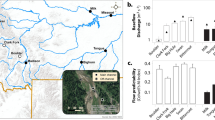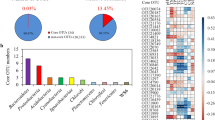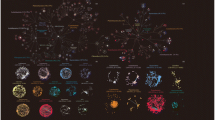Abstract
The composition, function, and assembly mechanism of the bacterial community are the focus of microbial ecology. Unsupervised machine learning may be a better way to understand the characteristics of bacterial metacommunities compared to the empirical habitat types. In this study, the composition, potential function, and assembly mechanism of the bacterial community in the arid river were analysed. The Dirichlet multinomial mixture method recognised four ecotypes across the three habitats (biofilm, water, and sediment). The bacterial communities in water are more sensitive to human activities. Bacterial diversity and richness in water decreased as the intensity of human activities increased from the region of water II to water I. Significant differences in the composition and potential function profile of bacterial communities between water ecotypes were also observed, such as higher relative abundance in the taxonomic composition of Firmicutes and potential function of plastic degradation in water I than those in water II. Habitat filtering may play a more critical role in the assembly of bacterial communities in the river biofilm, while stochastic processes dominate the assembly process of bacterial communities in water and sediment. In water I, salinity and mean annual precipitation were the main drivers shaping the biogeography of taxonomic structure, while mean annual temperature, total organic carbon, and ammonium nitrogen were the main environmental factors influencing the taxonomic structure in water II. These results would provide conceptual frameworks about choosing habitat types or ecotypes for the research of microbial communities among different niches in the aquatic environment.






Similar content being viewed by others
References
Berry MA, Davis TW, Cory RM, Duhaime MB, Johengen TH, Kling GW, Marino JA, Den Uyl PA, Gossiaux D, Dick GJ, Denef VJ (2017) Cyanobacterial harmful algal blooms are a biological disturbance to Western Lake Erie bacterial communities. Environ Microbiol 19:1149–1162. https://doi.org/10.1111/1462-2920.13640
Eiler A, Bertilsson S (2004) Composition of freshwater bacterial communities associated with cyanobacterial blooms in four Swedish lakes. Environ Microbiol 6:1228–1243. https://doi.org/10.1111/j.1462-2920.2004.00657.x
Zhang W, Lei M, Li Y, Wang P, Wang C, Gao Y, Wu H, Xu C, Niu L, Wang L, Zhang H (2019) Determination of vertical and horizontal assemblage drivers of bacterial community in a heavily polluted urban river. Water Res 161:98–107. https://doi.org/10.1016/j.watres.2019.05.107
Cai W, Li Y, Shen Y, Wang C, Wang P, Wang L, Niu L, Zhang W (2019) Vertical distribution and assemblages of microbial communities and their potential effects on sulfur metabolism in a black-odor urban river. J Environ Manag 235:368–376. https://doi.org/10.1016/j.jenvman.2019.01.078
Lindström ES, Langenheder S (2012) Local and regional factors influencing bacterial community assembly. Environ Microbiol Rep 4:1–9. https://doi.org/10.1111/j.1758-2229.2011.00257.x
PaudelAdhikari N, Liu Y, Liu K, Zhang F, Adhikari S, Chen Y, Liu X (2019) Bacterial community composition and diversity in Koshi River, the largest river of Nepal. Ecol Indic 104:501–511. https://doi.org/10.1016/j.ecolind.2019.05.009
Read DS, Gweon HS, Bowes MJ, Newbold LK, Field D, Bailey MJ, Griffiths RI (2015) Catchment-scale biogeography of riverine bacterioplankton. The ISME J 9:516–526. https://doi.org/10.1038/ismej.2014.166
Liu T, Zhang AN, Wang J, Liu S, Jiang X, Dang C, Ma T, Liu S, Chen Q, Xie S, Zhang T, Ni J (2018) Integrated biogeography of planktonic and sedimentary bacterial communities in the Yangtze River. Microbiome 6:16. https://doi.org/10.1186/s40168-017-0388-x
Zhang L, Zhong M, Li X, Lu W, Li J (2020) River bacterial community structure and co-occurrence patterns under the influence of different domestic sewage types. J Environ Manag 266:110590. https://doi.org/10.1016/j.jenvman.2020.110590
Chen L, Liu S, Chen Q, Zhu G, Wu X, Wang J, Li X, Hou L, Ni J (2020) Dispersal limitation drives biogeographical patterns of anammox bacterial communities across the Yangtze River. Appl Microbiol Biotechnol 104:5535–5546. https://doi.org/10.1007/s00253-020-10511-4
Wang J, Shen J, Wu Y, Tu C, Soininen J, Stegen JC, He J, Liu X, Zhang L, Zhang E (2013) Phylogenetic beta diversity in bacterial assemblages across ecosystems: deterministic versus stochastic processes. The ISME J 7:1310–1321. https://doi.org/10.1038/ismej.2013.30
Chen W, Ren K, Isabwe A, Chen H, Liu M, Yang J (2019) Stochastic processes shape microeukaryotic community assembly in a subtropical river across wet and dry seasons. Microbiome 7:138. https://doi.org/10.1186/s40168-019-0749-8
Gweon HS, Bowes MJ, Moorhouse HL, Oliver AE, Bailey MJ, Acreman MC, Read DS (2021) Contrasting community assembly processes structure lotic bacteria metacommunities along the river continuum. Environ Microbiol 23:484–498. https://doi.org/10.1111/1462-2920.15337
Wang L, Han M, Li X, Yu B, Wang H, Ginawi A, Ning K, Yan Y (2021) Mechanisms of niche-neutrality balancing can drive the assembling of microbial community. Mol Ecol 30:1492–1504. https://doi.org/10.1111/mec.15825
Zeglin LH (2015) Stream microbial diversity in response to environmental changes: review and synthesis of existing research. Front Microbiol 6:454
Gao Y, Zhang W, Li Y, Wu H, Yang N, Hui C (2021) Dams shift microbial community assembly and imprint nitrogen transformation along the Yangtze River. Water Res 189:116579. https://doi.org/10.1016/j.watres.2020.116579
Liu X, Li L, Qi Z, Han J, Zhu Y (2017) Land-use impacts on profile distribution of labile and recalcitrant carbon in the Ili River Valley, northwest China. Sci Total Environ 586:1038–1045. https://doi.org/10.1016/j.scitotenv.2017.02.087
Li C, Wang R, Xu J, Luo Y, Tan ML, Jiang Y (2018) Analysis of meteorological dryness/wetness features for spring wheat production in the Ili River basin, China. Int J Biometeorol 62:2197–2204. https://doi.org/10.1007/s00484-018-1623-2
Magoč T, Salzberg SL (2011) FLASH: fast length adjustment of short reads to improve genome assemblies. Bioinformatics 27:2957–2963. https://doi.org/10.1093/bioinformatics/btr507
Bolger AM, Lohse M, Usadel B (2014) Trimmomatic: a flexible trimmer for Illumina sequence data. Bioinformatics 30:2114–2120. https://doi.org/10.1093/bioinformatics/btu170
Edgar RC, Haas BJ, Clemente JC, Quince C, Knight R (2011) UCHIME improves sensitivity and speed of chimera detection. Bioinformatics 27:2194–2200. https://doi.org/10.1093/bioinformatics/btr381
Edgar RC (2013) UPARSE: highly accurate OTU sequences from microbial amplicon reads. Nat Methods 10:996–998. https://doi.org/10.1038/nmeth.2604
Bokulich NA, Subramanian S, Faith JJ, Gevers D, Gordon JI, Knight R, Mills DA, Caporaso JG (2013) Quality-filtering vastly improves diversity estimates from Illumina amplicon sequencing. Nat Methods 10:57–59. https://doi.org/10.1038/nmeth.2276
Quast C, Pruesse E, Yilmaz P, Gerken J, Schweer T, Yarza P, Peplies J, Glöckner FO (2013) The SILVA ribosomal RNA gene database project: improved data processing and web-based tools. Nucleic Acids Res 41:D590–D596. https://doi.org/10.1093/nar/gks1219
Louca S, Parfrey LW, Doebeli M (2016) Decoupling function and taxonomy in the global ocean microbiome. Science 353:1272. https://doi.org/10.1126/science.aaf4507
Liu C, Cui Y, Li X, Yao M (2021) microeco: an R package for data mining in microbial community ecology. FEMS Microbiol Ecol 97. https://doi.org/10.1093/femsec/fiaa255
Chen W, Wen D (2021) Archaeal and bacterial communities assembly and co-occurrence networks in subtropical mangrove sediments under Spartina alterniflora invasion. Environ Microbiome 16:10. https://doi.org/10.1186/s40793-021-00377-y
Sloan WT, Lunn M, Woodcock S, Head IM, Nee S, Curtis TP (2006) Quantifying the roles of immigration and chance in shaping prokaryote community structure. Environ Microbiol 8:732–740. https://doi.org/10.1111/j.1462-2920.2005.00956.x
Arumugam M, Raes J, Pelletier E, Le Paslier D, Yamada T, Mende DR, Fernandes GR, Tap J, Bruls T, Batto J-M, Bertalan M, Borruel N, Casellas F, Fernandez L, Gautier L, Hansen T, Hattori M, Hayashi T, Kleerebezem M, Kurokawa K, Leclerc M, Levenez F, Manichanh C, Nielsen HB, Nielsen T, Pons N, Poulain J, Qin J, Sicheritz-Ponten T, Tims S, Torrents D, Ugarte E, Zoetendal EG, Wang J, Guarner F, Pedersen O, de Vos WM, Brunak S, Doré J, Antolín M, Artiguenave F, Blottiere HM, Almeida M, Brechot C, Cara C, Chervaux C, Cultrone A, Delorme C, Denariaz G, Dervyn R, Foerstner KU, Friss C, van de Guchte M, Guedon E, Haimet F, Huber W, van Hylckama-Vlieg J, Jamet A, Juste C, Kaci G, Knol J, Kristiansen K, Lakhdari O, Layec S, Le Roux K, Maguin E, Mérieux A, Melo Minardi R, M’Rini C, Muller J, Oozeer R, Parkhill J, Renault P, Rescigno M, Sanchez N, Sunagawa S, Torrejon A, Turner K, Vandemeulebrouck G, Varela E, Winogradsky Y, Zeller G, Weissenbach J, Ehrlich SD, Bork P, Meta HITC (2011) Enterotypes of the human gut microbiome. Nature 473:174–180. https://doi.org/10.1038/nature09944
Gu W, Lu Y, Tan Z, Xu P, Xie K, Li X, Sun L (2017) Fungi diversity from different depths and times in chicken manure waste static aerobic composting. Bioresour Technol 239:447–453. https://doi.org/10.1016/j.biortech.2017.04.047
Phandanouvong-Lozano V, Sun W, Sanders JM, Hay AG (2018) Biochar does not attenuate triclosan’s impact on soil bacterial communities. Chemosphere 213:215–225. https://doi.org/10.1016/j.chemosphere.2018.08.132
Chen C-H, Lin Y-L, Chen K-H, Chen W-P, Chen Z-F, Kuo H-Y, Hung H-F, Tang CY, Liou M-L (2017) Bacterial diversity among four healthcare-associated institutes in Taiwan. Sci Rep 7:8230. https://doi.org/10.1038/s41598-017-08679-3
O’Brien JD, Record NR, Countway P (2016) The power and pitfalls of Dirichlet-multinomial mixture models for ecological count data. bioRxiv: 045468. https://doi.org/10.1101/045468
Matcher GF, Froneman PW, Meiklejohn I, Dorrington RA (2018) Distinct responses of bacterial communities to agricultural and urban impacts in temperate southern African estuaries. Estuar Coast Shelf Sci 200:224–233. https://doi.org/10.1016/j.ecss.2017.11.015
Yang Y, Li S, Gao Y, Chen Y, Zhan A (2019) Environment-driven geographical distribution of bacterial communities and identification of indicator taxa in Songhua River. Ecol Indic 101:62–70. https://doi.org/10.1016/j.ecolind.2018.12.047
Niu A, Song L-Y, Xiong Y-H, Lu C-J, Junaid M, Pei D-S (2019) Impact of water quality on the microbial diversity in the surface water along the Three Gorge Reservoir (TGR), China. Ecotoxicol Environ Saf 181:412–418. https://doi.org/10.1016/j.ecoenv.2019.06.023
Sharmin F, Wakelin S, Huygens F, Hargreaves M (2013) Firmicutes dominate the bacterial taxa within sugar-cane processing plants. Sci Rep 3:3107. https://doi.org/10.1038/srep03107
Antwi P, Li J, OpokuBoadi P, Meng J, Shi E, Xue C, Zhang Y, Ayivi F (2017) Functional bacterial and archaeal diversity revealed by 16S rRNA gene pyrosequencing during potato starch processing wastewater treatment in an UASB. Bioresour Technol 235:348–357. https://doi.org/10.1016/j.biortech.2017.03.141
Gharechahi J, Vahidi MF, Bahram M, Han J-L, Ding X-Z, Salekdeh GH (2021) Metagenomic analysis reveals a dynamic microbiome with diversified adaptive functions to utilize high lignocellulosic forages in the cattle rumen. The ISME J 15:1108–1120. https://doi.org/10.1038/s41396-020-00837-2
Murphy CL, Biggerstaff J, Eichhorn A, Ewing E, Shahan R, Soriano D, Stewart S, VanMol K, Walker R, Walters P, Elshahed MS, Youssef NH (2021) Genomic characterization of three novel Desulfobacterota classes expand the metabolic and phylogenetic diversity of the phylum. Environ Microbiol. https://doi.org/10.1111/1462-2920.15614
Echenique-Subiabre I, Zancarini A, Heath MW, Wood SA, Quiblier C, Humbert J-F (2018) Multiple processes acting from local to large geographical scales shape bacterial communities associated with Phormidium (cyanobacteria) biofilms in French and New Zealand rivers. Sci Rep 8:14416. https://doi.org/10.1038/s41598-018-32772-w
Majdi N, Uthoff J, Traunspurger W, Laffaille P, Maire A (2020) Effect of water warming on the structure of biofilm-dwelling communities. Ecol Indic 117:106622. https://doi.org/10.1016/j.ecolind.2020.106622
Mayr MJ, Besemer K, Sieczko A, Demeter K, Peduzzi P (2020) Bacterial community composition and function along spatiotemporal connectivity gradients in the Danube floodplain (Vienna, Austria). Aquat Sci 82:28. https://doi.org/10.1007/s00027-020-0700-x
Jones SE, Newton RJ, McMahon KD (2009) Evidence for structuring of bacterial community composition by organic carbon source in temperate lakes. Environ Microbiol 11:2463–2472. https://doi.org/10.1111/j.1462-2920.2009.01977.x
Liu Y, Yao T, Jiao N, Zhu L, Hu A, Liu X, Gao J, Chen Z-Q (2013) Salinity impact on bacterial community composition in five high-altitude lakes from the Tibetan Plateau, western China. Geomicrobiol J 30:462–469. https://doi.org/10.1080/01490451.2012.710709
Li H, Chi Z, Li J, Wu H, Yan B (2019) Bacterial community structure and function in soils from tidal freshwater wetlands in a Chinese delta: potential impacts of salinity and nutrient. Sci Total Environ 696:134029. https://doi.org/10.1016/j.scitotenv.2019.134029
Yimit H, Eziz M, Mamat M, Tohti G (2011) Variations in groundwater levels and salinity in the Ili River Irrigation Area, Xinjiang, northwest China: a geostatistical approach. Int J Sustain Dev World Ecol 18:55–64. https://doi.org/10.1080/13504509.2011.544871
Xu L, Du H, Zhang X (2019) Spatial distribution characteristics of soil salinity and moisture and its influence on agricultural irrigation in the Ili River Valley. China Sustainability 11:7142
Jiao S, Lu Y (2020) Soil pH and temperature regulate assembly processes of abundant and rare bacterial communities in agricultural ecosystems. Environ Microbiol 22:1052–1065. https://doi.org/10.1111/1462-2920.14815
Funding
This work was supported by the National Natural Science Foundation of China (grant number 41673127) and grants from the Youth Innovation Promotion Association of the Chinese Academy of Sciences (grant number Y201976 and 2017478).
All the raw data sets are publicly available in the Sequence Read Archive (SRA) of the National Center for Biotechnology Information (NCBI) under project accession no. PRJNA733708.
Author information
Authors and Affiliations
Contributions
W.S. and R.Q. conceived and designed the study; W.S., N.X., and R.Q. collected the samples and data; Y.Y. and W.S. performed the analysis; and W.S., X.Z., and L.Z. wrote and revised the manuscript.
Corresponding author
Ethics declarations
Ethics Approval
Not applicable.
Consent to Participate
Not applicable.
Consent for Publication
All authors agreed to publish this manuscript.
Conflict of Interest
The authors declare no competing interests.
Supplementary Information
Below is the link to the electronic supplementary material.
Rights and permissions
About this article
Cite this article
Qi, R., Xue, N., Zhou, X. et al. Distinct Composition and Assembly Processes of Bacterial Communities in a River from the Arid Area: Ecotypes or Habitat Types?. Microb Ecol 84, 769–779 (2022). https://doi.org/10.1007/s00248-021-01902-9
Received:
Accepted:
Published:
Issue Date:
DOI: https://doi.org/10.1007/s00248-021-01902-9




